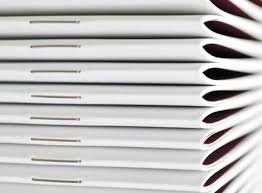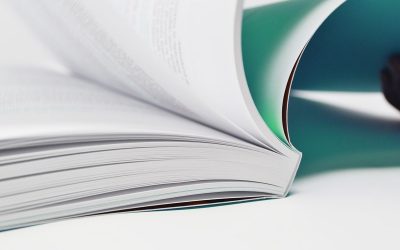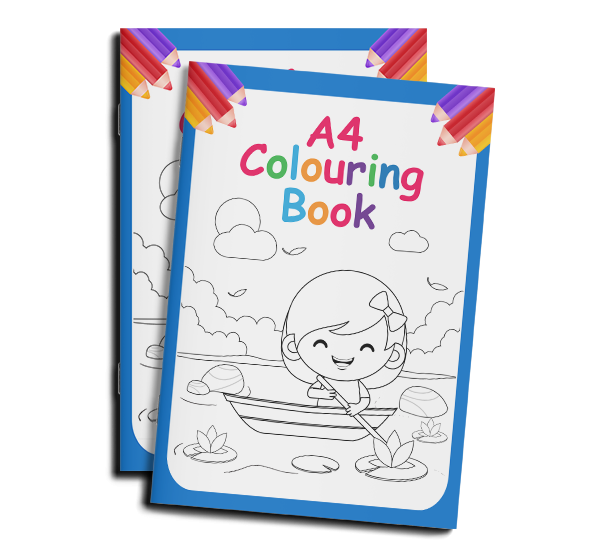
The choice of binding method for printing books, brochures, or other publications is crucial. Saddle stitch binding and perfect binding are two popular options, each with its own set of advantages and limitations. This article aims to highlight the differences between these methods, guiding you in selecting the most appropriate for your project – Print Saddle stitched Book types, or go for a Perfect Bound variation.
Whether you’re planning to print a budget-friendly saddle stitch booklet or a high-quality perfect bound book, this guide is here to help. We’ll examine key factors like page count, budget, and intended use. This will ensure you make the best choice for your needs, especially when considering booklet printing options.
Understanding Saddle Stitch Binding, and Print Saddle Stitched Book options

Saddle stitch binding is a cost-effective printing technique, ideal for smaller booklets and publications. It involves nesting pages inside each other and stapling along the centre fold. This method creates a professional-looking booklet that lays flat. It’s perfect for projects with fewer than 100 pages, offering advantages like faster turnaround, lower costs, and the flexibility to use a self-cover or a separate cover. Additionally, there is an extensive range of materials and configurations available for saddle stitch binding, catering to diverse needs and preferences.
What is Saddle Stitch Binding?
Saddle stitch binding is a simple yet effective method. It involves folding the pages in half and stapling along the centre crease, or “saddle”. This technique is commonly used for booklets, brochures, magazines, and other small-format publications. The staples used are longer than standard office staples, ensuring a secure and durable bind.
Advantages of Saddle Stitch Binding
- Cost-effective: Saddle stitch binding is a more cost-effective option compared to other binding methods, making it a popular choice for print runs of 500 or fewer.
- Fast turnaround: The simple folding and stapling process allows for a quicker printing and binding turnaround, meeting tight deadlines.
- Professional finish: Saddle stitched booklets have a clean, professional finish and can lay flat, enhancing their usability.
- Versatile paper options: Saddle stitch binding can be applied to a variety of paper types, including lightweight, coated, or glossy pages.
Limitations of Saddle Stitch Binding
While saddle stitch binding offers many benefits, it also has some limitations to consider:
- Page count restrictions: Saddle stitch binding is typically recommended for booklets with 4 to 64 pages. Books with more than 64 pages may not lay flat and could experience issues with the binding.
- Potential for “creep”: As the page count increases, the inner pages can protrude slightly beyond the outer pages, causing a phenomenon known as “creep”. This can affect the overall appearance and usability of the booklet.
Understanding these advantages and limitations of saddle stitch binding can help you make an informed decision when choosing the right binding method for your print project.
Exploring Perfect Binding

Perfect binding, also known as adhesive binding, is a robust and professional-looking method. It’s commonly used for books with a higher page count. The pages are glued to the spine, which is part of the front cover, creating a smooth, seamless appearance. This technique offers several benefits, making it a popular choice for various printing needs.
What is Perfect Binding?
Perfect binding is a method where pages are glued to the spine, which is then attached to the front and back covers. This results in a clean, professional look with a square spine, allowing for text to be printed on it. It’s commonly used for books, magazines, catalogs, and other publications with a higher page count, typically starting from 24 pages or more.
Benefits of Perfect Binding
- Durable and Aesthetically Pleasing: Perfect binding provides a more durable and visually appealing finish compared to other binding methods, making it a popular choice for publications that require a professional and polished appearance.
- Spine Printing: The square spine of a perfect-bound book or booklet allows for printing of titles, author names, volume numbers, and other relevant information, enhancing the overall presentation.
- Customization Options: Perfect binding offers greater flexibility in terms of page and cover customization, allowing for the creation of unique and visually striking publications.
- Shelf-Friendly: Perfect-bound books can stand upright on bookshelves or be stacked neatly, making them easy to organize and access.
Whether you’re creating a high-quality book, a comprehensive catalogue, or a sleek publication, perfect binding can provide the professional finish and durability your project deserves.
Cost-Effectiveness and Turnaround Time
When it comes to choosing a binding method, cost-effectiveness and turnaround time are crucial factors. Saddle stitch binding is often the go-to for budget-conscious projects due to its lower production costs. This method is particularly cost-effective for smaller print runs, making it an excellent choice for businesses and individuals looking to print booklets without breaking the bank.
Perfect binding, while generally more expensive, offers a polished and professional finish that justifies the higher cost for larger projects. This method is ideal for publications that require a durable and aesthetically pleasing appearance, such as high-quality books and magazines.
Evaluating Budget and Deadlines
Evaluating your budget and deadlines is essential to ensure your project stays on track. Here are some key considerations:
- Number of Booklets: The quantity of booklets you need can significantly impact your budget. Saddle stitch binding is more economical for smaller quantities, while perfect binding may be more cost-effective for larger print runs.
- Design Complexity: The complexity of your booklet design can affect both cost and production time. Simple designs with fewer pages are quicker and cheaper to produce with saddle stitching.
- Paper and Binding Options: The type of paper and binding method you choose will also influence the overall cost. Saddle stitch booklets can be printed on a variety of paper stocks, including uncoated paper, while perfect binding offers more customization options for both inner pages and covers.
- Turnaround Time: If you have a tight deadline, saddle stitch binding offers a faster turnaround due to its straightforward folding and stapling process. Perfect binding, on the other hand, requires additional time for the adhesive to cure, which can extend the production timeline.
By carefully evaluating these factors, you can choose the binding method that best fits your budget and timeline, ensuring a successful print project.
Print Saddle Stitched Book: Key Considerations

When you’re thinking about printing a print saddle stitched book, several key factors come into play. The page count is critical, as saddle stitch binding excels with projects under 100 pages. Your budget and the intended use and purpose of the book also play a role. Saddle stitch is often more cost-effective, but perfect binding might be better for larger, higher-quality books meant for display or resale. Additionally, booklet printing offers a variety of options, including cheap printing services, fast turnaround times, and different sizes to suit your needs.
Page Count Restrictions
Saddle stitched book printing is perfect for booklets and brochures with fewer pages, typically under 76. It’s not ideal for thicker booklets or books with many printed pages.
Budget Constraints
On a tight budget? Saddle stitch binding is a more cost-effective option. It’s a favorite for creating saddle stitched booklets, brochures, and other small printed materials.
Intended Use and Purpose
Saddle stitched books are versatile, suitable for annual reports, capability statements, magazines, school yearbooks, calendars, and more. Yet, for a higher-quality, more durable book intended for display or resale, perfect binding might be the superior choice.
Applications to Print Saddle Stitched Book and Books for
Saddle stitch booklets are incredibly versatile and can be used for a wide range of applications. Their cost-effectiveness and professional finish make them a popular choice for various types of printed materials.
Catalogue Printing and Marketing Materials
Saddle stitch booklets are ideal for catalogue printing and marketing materials. They provide a visually appealing and easy-to-read format, perfect for showcasing products, services, and company information. Common applications include:
- Product Catalogues: Display your product range in a sleek, organized manner.
- Company Brochures: Share your company’s story, values, and services with potential clients.
- Marketing Materials: Create impactful sales sheets and promotional booklets.
- Event Programs: Provide attendees with a detailed schedule and information about your event.
These booklets can be printed in various sizes, from A4 to A6, and customized with different paper stocks and binding options, making them a flexible choice for any marketing need.
Custom Colouring Books and Educational Materials

Saddle stitch booklets are also perfect for creating custom colouring books and educational materials. Their interactive and engaging format makes them suitable for both children and adults. Common applications include:
- Colouring Books: Design unique colouring books for kids or adults, perfect for relaxation and creativity.
- Activity Books: Create fun and educational activity books that keep readers engaged.
- Workbooks: Develop comprehensive workbooks for students, complete with exercises and lessons.
- Educational Guides: Produce informative guides on various topics, ideal for classroom or self-study use.
- Study Materials: Compile study guides and revision booklets to aid in learning.
These booklets can be printed in a range of sizes and customized with various paper stocks and binding options, making them a cost-effective and efficient way to produce large quantities of educational materials.
By understanding the diverse applications of saddle stitch booklets, you can leverage this binding method to create effective and engaging printed materials for any purpose.
Comparing the Two Binding Methods
Choosing between saddle stitch and perfect binding involves several considerations. Saddle stitch is ideal for smaller projects with up to 48 pages. It’s a cost-effective method that uses wire staples, making it budget-friendly. Perfect binding, however, is better suited for larger books with over 96 pages. It offers a more professional and durable finish.
Saddle stitch binding is known for its speed and efficiency. The use of wire staples allows for a quicker turnaround compared to perfect binding’s adhesive curing process. This makes it a practical choice for projects with tight deadlines.
Perfect binding, on the other hand, excels in durability and printability. Its flat spine is perfect for title printing, ideal for books, magazines, and catalogues on shelves. The use of Polyurethane Reactive (PUR) glue also enhances page resilience, reducing pull-out risk.
The choice between saddle stitch and perfect binding depends on your project’s needs. Consider the page count, budget, and intended use. Understanding each method’s strengths and limitations is key to achieving a professional finish that meets your printing needs.
Choosing the Right Binding for Your Project
When selecting a binding method for your project, several factors come into play. The decision between saddle stitch and perfect binding hinges on your project’s specifics. These include page count, budget, and the product’s intended use.
Saddle stitch binding is perfect for smaller booklets and brochures with fewer pages. It’s ideal for documents with 8 to 80 pages. This method offers a neat, professional finish that stays flat when opened and closed.
Perfect binding, however, is more suitable for larger books and magazines needing a durable, polished finish. It’s best for documents with 32 to 240 pages, making it ideal for extensive projects.
Considering budget, saddle stitch is more affordable, especially for smaller projects or shorter runs. Perfect binding, while offering a refined look, is better for larger print runs or projects with higher value.
The choice between saddle stitch and perfect binding depends on your project’s needs. By evaluating page count, budget, and intended use, you can select the best binding method. This ensures your project meets your requirements and achieves the desired outcome.
Conclusion
The decision between saddle stitch and perfect binding hinges on several factors. These include page count, budget, and the product’s intended use. Saddle stitch binding is ideal for smaller booklets and publications, offering a cost-effective solution. On the other hand, perfect binding is preferred for larger books, magazines, and catalogues, providing a more durable and professional finish.
Assessing your specific needs is crucial for making an informed choice. Whether you need a cost-effective option for a small booklet or a professional finish for a larger publication, there’s a binding method to suit your printing needs. The wide range of binding options ensures you can find the perfect match for your project.
Ultimately, the choice between saddle stitch and perfect binding is about finding a balance. Consider page count, budget, and the desired professional finish for your booklet or publication. By weighing these factors, you can create a high-quality, cost-effective print product that meets your project’s objectives and your audience’s expectations.








